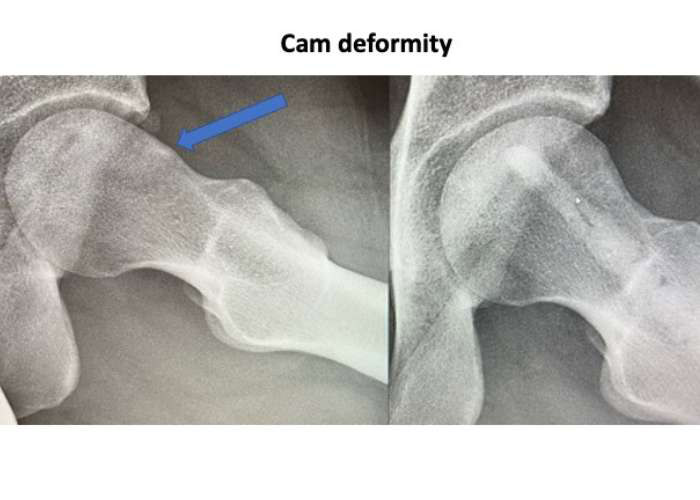Dr. Benedict Nwachukwu, FAI Hip Impingement and Cam Deformity Specialist in NYC, Answers:

Q: What is a cam deformity of the hip?
A cam deformity of the hip is a condition where a bone spur, bump, or congenital deformity misshapes the normally round ball of the hip joint (femoral head) so that it cannot freely rotate in the hip socket (acetabulum). Femoroacetabular impingement (FAI) can commonly occur from a cam deformity due to the femoral head knocking and rubbing against the acetabulum, damaging the cartilage and labrum. A cam deformity of the hip can often be asymptomatic for years before a patient notices a problem.
Common symptoms of a cam deformity include:
- Pain in the groin area, especially with sitting
- Pain that can vary from a dull ache to stabbing and intense.
- Stiffness and decreased range of motion
- A sensation of clicking or popping in the hip
If you are experiencing these symptoms, it may be time to consult with an orthopedic hip doctor to determine appropriate treatment options.
“When we detect a cam deformity early, we have the opportunity to preserve the hip and prevent long-term damage to the labrum and cartilage. The key is recognizing the cause of impingement before it becomes more advanced.”
— Dr. Nwachukwu, Board Certified, Fellowship-Trained Orthopedic Surgeon
What is a cam deformity or a cam lesion?
The hip is a ball and a socket joint. The ball is called the femoral head and the socket is called the acetabulum. In patients with a cam deformity, the head is not perfectly spherical and does not fit well into the socket. In this condition there is an abnormality of the femoral head and neck junction leading to bony overgrowth of the femoral head and neck. If the head of the femur is not shaped normally it can get caught in the socket when the hip is bent. Simple activities such as tying one’s shoes or riding a bike can cause this to happen and can be very painful.
What causes a cam deformity?
The available evidence suggests that cam deformities are a developmental issue that occurs more commonly in adolescents involved in sports. In these adolescents, being engaged in certain sports while the growth plate is open can stimulate the growth plate of the hip to form extra bone which then becomes the cam deformity.
How common is a cam deformity?
Population-level studies have suggested that cam deformities are fairly common in the United States. As many as 40% of individuals may have a cam deformity and in a patient population who participates in sports, this condition can be present in as many as 60%. Although cam deformities are common, they do not necessarily cause pain in everyone. Patients in Manhattan, Brooklyn, New York City, and the surrounding New York boroughs who have a cam deformity or who are experiencing persistent hip pain, need to seek a specialist like Dr. Benedict Nwachukwu. Dr. Nwachukwu has done extensive research and has had excellent results in treating patients with a cam deformity and resulting hip pain.
Does a cam deformity cause hip impingement?
Cam deformities are due to loss of the sphericity (round shape) of this femoral head. As a result, the labrum can become “pinched” between the bone of the socket and the bone of the ball and is referred to as femoroacetabular impingement or FAI.
What are the symptoms of a cam impingement?
Symptoms of cam impingement are most commonly related to the mechanical grinding of the excessive bone. Patients will often report the following:
- Pain in the groin area, especially with sitting
- Pain that can vary from a dull ache to stabbing and intense.
- Stiffness and decreased range of motion
- A sensation of clicking or popping in the hip
How can I treat my cam deformity without surgery?
Approximately 60% of patients with cam lesions can be treated successfully without surgery. The mainstay of non-operative treatment of cam impingement is physical therapy. Strengthening the muscles around the hip will allow patients to take weight off the affected joint and decrease the strain caused by the cam deformity. Other non-operative options that patients find helpful include a hip cortisone injection, NSAIDs, and activity modification.
What is the surgical treatment for a cam deformity?
Surgical treatment for a cam deformity can usually be done arthroscopically, a minimally invasive procedure using small incisions and specialized instruments. The goal of cam surgery, also called femoroplasty is to reshape the head and neck of the femur and remove the cam lesion or extra bone. Often, Dr. Nwachukwu will perform a labral repair at the same time because the labrum is commonly torn in patients with a cam impingement caused by a cam deformity.
What is the recovery time after hip impingement surgery?
In the first 3-4 weeks after hip impingement surgery, patients will be partial weight-bearing on the surgical side and will participate in physical therapy. The first six weeks after surgery are spent working on range of motion, while the 2nd six weeks are spent working on strengthening the hip. Progression to running can be attempted at 16 weeks with a goal of returning to sporting activities 6-9 months after surgery.
For more information and treatment options for a cam deformity or a hip impingement caused by a cam deformity, please contact the office of Benedict Nwachukwu, MD, orthopedic hip specialist serving Manhattan, Brooklyn, New York City and surrounding New York boroughs.

